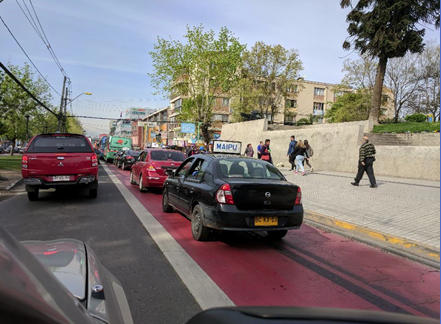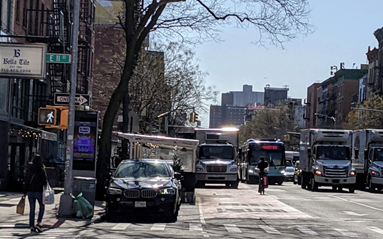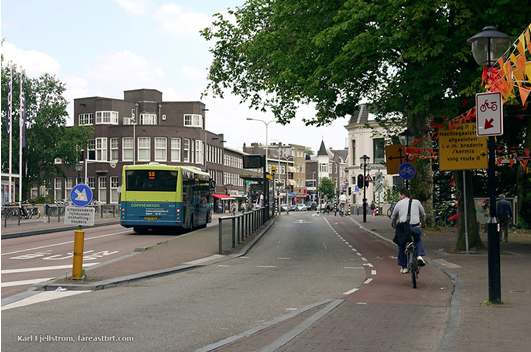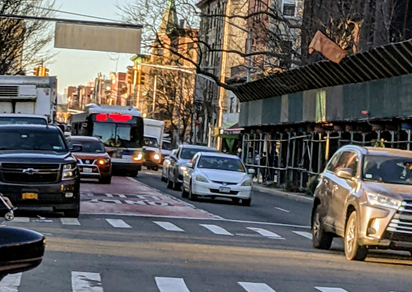Editor's Note: This article originally appeared on Reorientations and is republished here with the permission of the author.
Throughout my career as a bus advocate, I have been skeptical of curbside bus lanes. They are exceedingly easy to block. In fact, most curbside bus lanes come with a list of both illegal and legal encroachments.
- Illegal: driving in the bus lane, parking/stopping for extended periods of time in the bus lane, deliveries during certain hours, police stopping for a pizza.
- Legal: right turns, quick drop-offs, parallel parking if the lane is adjacent to a parking lane (“offset”), even deliveries during certain hours.
Illegal blockages are really hard to control
Curbside bus lanes get blocked illegally because they are close to the curb and the curb is where the action is. Taxis and other for-hire vehicles attempt to get as close as possible to a customer’s destination - this often means stopping in a bus lane. Delivery drivers don’t want to carry their deliveries further than necessary. Then, once other drivers see that the bus lane is blocked, it’s an invitation for them to stop or drive in the bus lane too.
Theoretically, vehicles illegally using a bus lane should be ticketed by police. But the number of summonses is rarely anywhere near the number needed to keep the lanes clear. In New York, police enforcement of bus lanes dropped significantly between 2013 and 2018. In fact, police themselves are often the ones blocking the lanes. And New York is not alone. Chicago faces illegal bus lane violations on the Jeffery Jump and the Loop Link downtown.
This problem is hardly limited to the US. Santiago de Chile, notorious for poor enforcement, installed a curbside bus lane on Avenida Pajaritos and it was almost immediately filled with traffic.

Cities and advocates have longed pushed for automated camera enforcement as the solution to these problems. In 2019, New York State passed a bill that would remove caps on the number of cameras in bus lanes. This was a hard-fought win for transit and bus lane advocates. Automated Bus Lane Enforcement (ABLE) Cameras have been installed at specific locations along certain bus lanes as well as on-board buses on certain bus routes, including the M15-Select Bus Service. If two buses in a row catch a vehicle in the bus lane, it is assumed to be a violator and is issued a ticket.
Indeed, the bus lane cameras appear to have brought some benefits and the MTA claims speed increases. The program should be expanded. But cameras are not a panacea.
I went to First Avenue on a nice day last week to observe the M15-SBS cameras in action. I chose a stretch of 1st Avenue where bus lanes were in effect, as it was around 1pm and certain blocks allow obstructions between 10am — 2pm while others are 24/7 (these complicated rules certainly don’t help with the problem of bus lane encroachments). The bus lanes had one to two illegal blockages per block. As a result, the buses did not once travel in the bus lanes I was observing.

I made similar observations during the evening peak on Bedford Avenue in Brooklyn, just to be sure, and found the same thing.

It is not clear why, with bus lane cameras, the lanes are still blocked. Perhaps it is because the lanes are so blocked that buses can’t always use the lanes and therefore are not photographing vehicles directly in front of them; perhaps there was a technical glitch on my days of observation; perhaps something more cynical is going on with the actual decision of when and how many violations to issue. These problems may or may not be solvable. What is clear, however, is that even though the cameras have issued many violations, they are still not doing the necessary job of entirely clearing the bus lanes.
Legal blockages are… legal
So we have not really solved the illegal bus lane blockage problem. Perhaps we could. But the problem remains that most curbside bus lanes come with a slew of fully legal reasons for non-buses to enter the bus lane. In NYC, these include:
- The motorist is about to enter a driveway or make a right turn at the nearest intersection.
- The motorist temporarily stops to expeditiously pick up or drop off a passenger at the curbside.
- The motorist is attempting to access a parking spot next to the bus lane.
As it turns out, these are very common things. Importantly, they are all inherent to the curbside nature of the bus lanes.
One of the worst, and yet legal, delays to buses in a bus lane is when a bus gets stuck behind a legally right turning vehicle in the bus lane (see #1 above) that is, in turn, waiting for pedestrians to clear the crosswalk at a highly foot-trafficked urban block. One solution is to outright ban right turns. I would like to see much more of this. But, not surprisingly, city departments of transportation are not keen on it.

Another solution is to provide right turning pockets to the right of the bus lane (cars travel across the bus lane to reach them). This is growing in popularity but is far from standard practice and queuing from the right turn can still back up into the bus lane.
Cities can and should also require passenger pick-ups and drop-offs to occur on cross streets rather than in the bus lane. And of course, they should ban all parking adjacent to the bus lane.
These are all things that should be done. And once done, it would be theoretically possible to put up a small barrier to protect the bus lane from illegal violations. But the very fact that most curbside bus lanes do come with a list of legal reasons for entry indicates the general unwillingness of cities to restrict curbside access. This, combined with the difficulty in enforcing illegal violations have, to this day, added up to a very heavy lift to make curbside bus lanes work — indeed, almost none of them do.
Why do we keep building curbside bus lanes?
The inability of SBS and other bus lanes to provide unobstructed travel for buses has not stopped cities from planning and building more. The Philadelphia Transit Plan that was just released last month, includes curbside bus lanes as part of its toolkit and proposes them for several locations.
So why do we keep building them? Two reasons:
- They are not really dedicated. They seemingly provide dedicated space for buses but, with a wink and a nod, they allow other vehicles in too. Politically, it looks good to give space to buses and yet nothing has truly been taken away from cars.
- They are cheap and quick.They only require paint and some signs and can be put in quickly. This is no small thing as it can allow politicians to claim measurable success (something like, “I fulfilled my promise of creating 100 miles of new bus lanes since I was elected”). But is it true success if the bus lanes are not particularly effective?
Better design vs better enforcement
In the bike lane design space, advocates have long been calling for better design to compensate for poor enforcement. As Bike New York’s Jon Orcutt once said in reference to a 2019 bike infrastructure plan called ‘Green Wave,’ “We’ve focused on the DOT elements of ‘Green Wave‘ [plan]… because traffic enforcement ‘crackdowns’ are usually ephemeral, slow, off the mark or purely rhetorical.”
Perhaps moving traffic enforcement out of the purview of the police will help. But it is time, too, to focus on designing bus lanes in a way that avoids all the problems –legal and illegal — that impede buses.
Which bus lane designs work?
On standard two-way streets, two-way median-aligned bus lanes work best. When buses are in the median of the road, the reasons to block them are vastly reduced. Sure, you have your occasional scofflaw using the bus lane to circumvent traffic congestion but that *is* something that can be handled by on-board cameras. There are few legal reasons for non-bus vehicles to enter the bus lanes so it is more clear when someone is a violator.

Full busways are also great options and are gaining in popularity. The 14th Street Busway in NYC is the most recent example of a very successful busway. Full busways can be harder to implement on major arterials because they require closing the whole street off to cars, not just a few lanes. And, while probably difficult politically, they should also be considered on narrow streets like Bedford or Nostrand Avenues.
On one-way streets, designs can be more complicated but the options include: convert a one-way street into a two-way street and proceed with a two-way median-aligned busway, as above; build a one-way busway in the center of the street, as they did in Johannesburg (this can be confusing to drivers); build a two-way busway on the side of the one-way street. These options are detailed in The BRT Planning Guide, which I helped write when I was at ITDP. Of course, there are many more detailed options and each street should be considered on a case-by-case basis.
Many of these options require stations in the middle of the street and that does take more road real estate. Designing high-quality bus lanes therefore must be the decision of a city that is serious about transit and about reducing its CO2 footprint.
Yes, quality bus lanes will take longer and cost more money. But so, of course, would building a subway (much, much, more time and money). We should prioritize great transit in our cities and not settle for slow, blocked bus lanes simply because they’re cheap. Enforcement is political and may come and go over time and various political administrations; good design is permanent.






